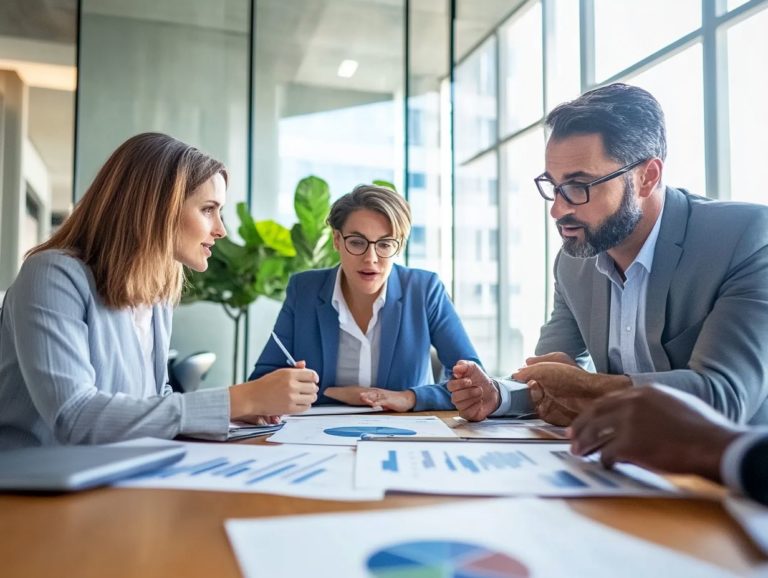What Are the Key Factors in Collectibles Valuation?
Collectibles captivate enthusiasts and investors. However, understanding their true value can be complicated.
This guide explores the key factors influencing collectibles’ worth. These include rarity, condition, and current market trends.
Discover effective valuation methods. You can use expert appraisals or handy online tools.
You ll find essential tips to avoid common pitfalls. Staying informed is key in this changing market.
Whether you re a seasoned collector or just starting, this guide equips you with must-have insights to thrive in the collectible market!
Contents
- Key Takeaways:
- Defining Collectibles and Their Value
- Factors Affecting Collectibles Value
- Methods of Collectibles Valuation
- Tips for Accurate Collectibles Valuation
- Frequently Asked Questions
- What Are the Key Factors in Valuing Collectibles?
- How Does Rarity Affect Collectibles Valuation?
- Why Is Demand an Important Factor in Collectibles Valuation?
- What Role Does Condition Play in Collectibles Valuation?
- How Does Authenticity Impact Collectibles Valuation?
- Why Is Provenance a Key Factor in Collectibles Valuation?
Key Takeaways:
- Rarity and Demand: The more scarce and in-demand an item is, the higher its value.
- Condition and Authenticity: Items in pristine condition with proven authenticity tend to be more valuable.
- Market Awareness: Stay updated on pop culture and current trends to identify collectibles that may appreciate in value.

Defining Collectibles and Their Value
Collectibles encompass a vast array of items that you may seek, treasure, and often invest in everything from Beanie Babies and trading cards to rare photographs and comic books.
Their value isn t just dictated by market trends; it s deeply influenced by emotional appeal, rarity, and unique features.
As collectibles traverse the intricate terrain of alternative investments, knowing their worth becomes essential for both seasoned collectors and novices alike, particularly when it comes to vintage cars and historical memorabilia.
This nuanced perspective on defining collectibles enables you to appreciate their unique attributes while fostering a deeper connection with the items you choose to cherish.
Factors Affecting Collectibles Value
The value of collectibles is shaped by a variety of factors that determine their desirability in the market, such as rarity, demand, condition, and authenticity of art.
Take, for example, Honus Wagner baseball cards and vintage Beanie Babies; their market value can experience dramatic fluctuations, influenced by emotional trends and current market dynamics.
By understanding these elements, you can make informed decisions and adeptly navigate the complexities of collectible investing, ensuring that you not only preserve your investments but also appreciate their unique characteristics as time goes on.
Rarity and Demand
Rarity and demand are the twin pillars that shape the market value of collectibles, influencing how much you re willing to invest in items with distinctive characteristics.
The charm of rare pieces think limited-edition trading cards or unique historical memorabilia can stir your emotions, compelling you to acquire items that truly resonate with your interests.
Consider the Pok mon phenomenon: first-edition cards skyrocketed in price due to their scarcity and nostalgic allure, showcasing how collectors often pay a premium for those elusive treasures.
Vintage comic books featuring iconic superheroes can also command staggering prices when their rarity aligns with consistent demand, especially among passionate fans.
By understanding these dynamics, you position yourself as a savvy collector, refining your investment strategies. You might choose to focus on emerging trends or collectibles with the potential to gain popularity in the future.
Grasping the patterns of rarity and demand not only enriches your collecting journey but can also pave the way for profitable investments over time.
Condition and Authenticity
The condition and authenticity of your collectibles are crucial factors in determining their value. Items in mint condition often command significantly higher prices in the market.
Condition grades serve as essential benchmarks for collectors, guiding appraisals and providing insight into the quality of items like vintage cars, comic books, and historical memorabilia. In today s market, ensuring authenticity is paramount, as counterfeit items can jeopardize both your investment and the emotional connection you have with your prized possessions.
Take comic books, for instance. A mere difference of one grade can lead to a dramatic price variation. A comic rated at 9.8 can vastly outshine its 9.0 counterpart, showcasing how vital it is to conduct meticulous condition assessments.
Rare photographs can also see their value fluctuate dramatically based on their preservation state.
To securely protect your beloved collectibles, consider investing in professional appraisals and keeping your items in controlled environments to minimize wear. By adopting these best practices, you can not only safeguard your collection but also enhance its value over time.
Pop Culture and Trends

Pop culture and current market trends play a pivotal role in shaping the collectibles landscape. They ignite a deep emotional connection for enthusiasts drawn to items like Spiderman comic books and Beanie Babies. The nostalgia tied to iconic characters or significant events fuels your enthusiasm, making you more inclined to invest in pieces that resonate with your passions.
As trends shift, it s essential to grasp their influence on the collectibles market to make informed investment decisions.
For example, the resurgence of superhero films has triggered a surge in the value of certain comic book issues, showcasing how cinematic milestones can breathe new life into vintage publications. Similarly, the early 2000s craze for Beanie Babies illustrates how fleeting trends can drastically inflate their worth, only for values to tumble when consumer interest fades.
You must stay nimble, adapting your focus to cultural phenomena, whether it’s the latest blockbuster hit or a viral trend online. These factors don t just shape demand they redefine what makes a collectible truly desirable.
Methods of Collectibles Valuation
Understanding how to value collectibles is essential for anyone involved in collectible investing. It enables you to gauge the true worth of items in the marketplace.
Key methods include:
- Professional appraisals
- Comparing prices of similar items currently being sold
- Using online valuation tools that offer valuable insights into current trends and pricing
By effectively leveraging these resources, you can attain a comprehensive understanding of your investments. This ensures that your decisions align with both your financial aspirations and the emotional connections you have to your collection.
Appraisal by Experts
Appraisal by experts is an essential step for collectors seeking to grasp the true value of their items. It provides credible insights and ensures that your collectibles are adequately insured. Expert appraisers draw upon their extensive knowledge to assess crucial factors such as rarity, condition, and authenticity elements that significantly impact the valuation of everything from vintage cars to rare comic books.
By understanding the appraisal process, you not only preserve the integrity of your collection but also position yourself to make informed investment decisions.
During an appraisal, expect a meticulous examination of your items. The expert will take notes and photographs to bolster their evaluation. This process isn t just about assigning a value; appraisers also provide valuable guidance on market trends and selling potential, which is vital for your strategic planning.
Having collectibles insurance is imperative, as it safeguards against loss, theft, or damage. Proper documentation from the appraisal can streamline claims and ensure that you can recover the full value of your prized possessions when necessary.
Thus, the appraisal process serves as a cornerstone for maintaining a thriving and well-protected collection.
In summary, understanding the condition, recognizing market trends, and seeking expert appraisals are key components in effectively valuing your collectibles. These elements not only enhance your investment but also enrich the emotional journey of collecting.
Market Comparison and Research
Conducting market comparisons and research is crucial for you as a collector to establish a baseline for your items’ market value. This enables you to navigate the emotional side of collecting with finesse.
By analyzing recent sales data, auction results, and online listings, you can gain valuable insights into what similar items are fetching in today s market. This careful research not only informs your pricing strategies but also deepens your understanding of the demand and trends affecting your cherished possessions.
Utilizing online platforms and specialized auction sites can significantly streamline your research process, making it much easier to compare values.
Engaging in forums and social media groups dedicated to specific collectibles can provide you with valuable insights from fellow enthusiasts. By connecting with a community of collectors, you can uncover hidden trends or shifts in preferences that might not be apparent through traditional listings alone.
Ultimately, this blend of emotional attachment and thorough market investigation gives you the power to make informed decisions about your beloved items, ensuring they are appreciated and valued appropriately.
Online Valuation Tools
Online valuation tools revolutionize how you assess the value of your collectibles, giving you immediate access to market trends and pricing information. With these platforms, you can effortlessly input details about your items whether they re comic books or vintage toys and receive estimates grounded in current market data.
By aggregating information from various sales channels, these tools provide not just approximate value ranges but also insights into historical pricing trends and potential future value predictions. Popular platforms like WorthPoint and GoAntiques have become favorites among enthusiasts for their comprehensive databases and intuitive interfaces.
You can confidently rely on these resources to cross-reference values, ensuring you develop a well-rounded understanding of your items’ worth. In this niche market, accuracy and reliability are crucial, as many tools utilize algorithms that consider recent sales and auction results, making them essential for navigating the complexities of collectible investments.
Tips for Accurate Collectibles Valuation

Achieving accurate valuations for collectibles demands your diligence and a keen awareness of market dynamics, allowing you to steer clear of common pitfalls that could jeopardize your investments.
By staying informed about market trends, grasping the emotional appeal behind your items, and recognizing their unique characteristics, you can navigate the valuation process with greater effectiveness.
This proactive approach deepens your appreciation for your collection and maximizes its intrinsic value and market potential. Don t miss out on maximizing the value of your collection!
Avoiding Common Mistakes
Avoiding common mistakes is crucial for collectors like you who want to achieve accurate valuations and make savvy decisions in the world of collectibles investing. It s easy to overlook essential elements like condition grades, authenticity checks, and relying on outdated market data, which can lead to serious miscalculations in your items’ values.
By educating yourself and actively engaging in the valuation process, you can protect your investments and cultivate a deeper appreciation for your collection.
One frequent pitfall is underestimating the impact of condition on value. For instance, a rare comic book in poor condition can plummet in value compared to an identical edition graded as mint.
Failing to verify authenticity can cost you. Counterfeit items might catch your eye, but they can lead to significant losses when you find you can t recoup your expenses.
To navigate these challenges, regularly consult current market trends, utilize reputable appraisal services, and connect with collector communities. This approach provides you with valuable insights and helps you steer clear of missteps, ensuring your collecting journey is both informed and rewarding.
Keeping Up with the Market
Staying aware of the market is crucial for collectors wanting to understand what influences their item’s value.
Engage with resources like online forums, newsletters, and specialized social media. These tools offer real-time updates and expert opinions that help you grasp shifts in taste and trends.
Engaging with the community connects you with fellow enthusiasts. Their knowledge and experiences can be invaluable.
Participating in workshops, webinars, and expos broadens your expertise. This education empowers you to make informed decisions that can significantly enhance your collection’s potential.
Frequently Asked Questions
What Are the Key Factors in Valuing Collectibles?
Key factors include rarity, demand, condition, authenticity, provenance, and market trends.
How Does Rarity Affect Collectibles Valuation?

Rarity is an important factor because the scarcer an item is, the more valuable it becomes. This is due to rarity creating a sense of exclusivity and making the item more desirable to collectors.
Why Is Demand an Important Factor in Collectibles Valuation?
Demand is crucial because it determines how much people are willing to pay for a particular item. The higher the demand for a collectible, the more valuable it becomes.
What Role Does Condition Play in Collectibles Valuation?
The condition of a collectible greatly affects its value. Collectibles in mint condition or with minimal wear and tear are often more valuable than those in poor condition.
How Does Authenticity Impact Collectibles Valuation?
Authenticity is vital as it ensures that the item is genuine and not a fake or reproduction. An authentic collectible is significantly more valuable than a fake or replica.
Why Is Provenance a Key Factor in Collectibles Valuation?
Provenance, or the history of an item, adds value. An item with a notable or interesting history is often more valuable than a similar item without known provenance.






